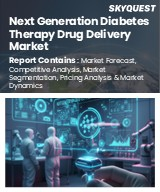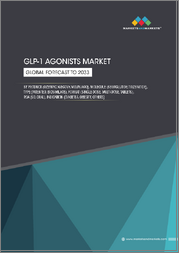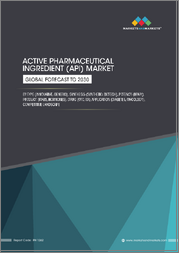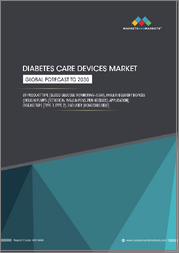
|
시장보고서
상품코드
1733211
세계의 당뇨병 치료제 시장 규모 : 약제별, 당뇨병 유형별, 유통 채널별, 지역 범위별 및 예측Global Diabetes Drugs Market Size By Drug (Injectable Drugs, Oral Drugs), By Diabetes Type (Type 1, Type 2), By Distribution Channel (Hospital Pharmacies, Rental Pharmacies, Online Pharmacies), By Geographic Scope and Forecast |
||||||
당뇨병 치료제 시장 규모 및 전망
당뇨병 치료제 시장 규모는 2025년에 667억 2,000만 달러로 평가되며 2026-2032년 연평균 6.00% 성장하여 2032년에는 1,019억 2,000만 달러에 달할 것으로 예측됩니다.
당뇨병 치료제는 당뇨병 환자의 혈당 조절을 돕기 위해 사용되는 의약품입니다. 당뇨병은 체내에서 인슐린이 충분히 분비되지 않거나(제1형), 인슐린에 저항성을 보이는(제2형) 만성질환입니다. 이 약들은 당뇨병 유형과 환자의 요구에 따라 다양한 작용을 나타냅니다.
당뇨병 치료제는 1형 당뇨병과 2형 당뇨병을 관리하고, 정상 혈당을 유지하며, 합병증 위험을 낮추기 위해 환자를 돕는 데 있어 매우 중요합니다. 당뇨병 치료제는 인슐린, 설포닐우레아, 메트포르민, GLP-1 수용체 작용제 및 SGLT2 억제제와 같은 새로운 치료법 등 여러 범주로 나뉩니다.
당뇨병 치료제의 미래는 지속적인 연구와 기술의 비약적인 발전으로 유망한 것으로 보입니다. 전 세계 당뇨병 유병률 증가와 더불어 맞춤형 치료의 중요성이 강조됨에 따라 특정 환자의 요구에 맞는 치료법 개발이 진행될 것으로 예측됩니다. 새로운 약물 제제 및 병용요법은 부작용을 최소화하면서 효능을 향상시키기 위해 연구되고 있습니다.
세계의 당뇨병 치료제 시장 역학
세계 당뇨병 치료제 시장을 형성하는 주요 시장 역학은 다음과 같습니다.
주요 시장 성장 촉진요인
당뇨병 유병률 증가: 당뇨병 유병률 증가: 당뇨병은 점점 더 흔해지고 있으며, 특히 2형 당뇨병은 당뇨병 치료제 산업의 주요 견인차 역할을 하고 있습니다. 국제당뇨병연맹에 따르면, 2045년까지 당뇨병을 앓고 있는 성인의 수는 7억 명에 달할 것으로 예상되며, 효과적인 당뇨병 치료제 선택에 대한 수요가 증가하고 있습니다.
의약품 개발의 발전: 의약품 연구 개발의 끊임없는 발전은 당뇨병 치료제 산업에 큰 영향을 미치고 있으며, SGLT2 억제제, GLP-1 수용체 작용제, DPP-4 억제제 등 혁신적인 치료제의 개발로 당뇨병 치료제 선택의 폭이 넓어지고 있습니다. 이러한 새로운 약제군은 우수한 효능과 안전성 프로파일과 함께 체중 감소 및 심혈관 보호와 같은 다른 이점을 가지고 있습니다.
당뇨병과 그 영향에 대한 지식이 증가함에 따라 보다 적극적인 검진 및 조기 진단이 이루어지고 있습니다. 정부 프로그램과 의료 기관은 당뇨병 관리의 필요성과 조기 개입의 이점에 대한 인식을 높이고 있습니다.
주요 과제
높은 개발 비용: 당뇨병 치료제 연구개발(R&D)은 특히 많은 비용이 소요됩니다. 그 이유는 당뇨병이라는 질병의 복잡성과 안전성과 유효성을 확인하기 위해 필요한 광범위한 검사가 필요하기 때문입니다. 새로운 당뇨병 치료제를 개발하기 위해서는 엄격한 전임상 연구, 임상시험, 규제 당국의 허가가 필요하며, 이는 오랜 기간과 많은 자금이 필요합니다.
산업 경쟁과 가격 압력: 당뇨병 치료제 산업은 여러 기존 기업과 다양한 제네릭 의약품이 존재하기 때문에 치열한 경쟁이 벌어지고 있습니다. 이러한 치열한 경쟁은 브랜드 의약품 제조업체와 제네릭 의약품 제조업체의 이익률에 영향을 미칠 수 있는 큰 가격 압력으로 작용하고 있습니다.
환자 순응도 및 복약 순응도: 환자가 당뇨병 치료제를 처방대로 복용하는 것은 여전히 큰 관심사입니다. 복잡한 투약 요법, 부작용, 불충분한 환자 교육 등이 모두 복약 순응도를 떨어뜨리는 요인으로 작용합니다. 약물 순응도 위반은 치료 효과 저하, 의료비 증가, 결과 위험 증가로 이어질 수 있습니다.
주요 동향
GLP-1 수용체 작용제에 대한 관심 증가: 당뇨병 치료제 산업은 글루카곤 유사 펩타이드-1(GLP-1) 수용체 작용제에 대한 관심으로 크게 전환하고 있습니다. 이 약물은 혈당 조절뿐만 아니라 체중 감량에도 도움이 되기 때문에 비만이나 과체중이 많은 2형 당뇨병 환자에게 특히 매력적입니다. 이러한 약물의 두 가지 장점으로 인해 배합과 수요가 증가하고 있습니다.
바이오시밀러의 등장: 인기 있는 당뇨병 치료제의 특허가 만료됨에 따라 바이오시밀러가 각광을 받고 있습니다. 이러한 생물학적으로 동등한 의약품은 오리지널 의약품보다 저렴하기 때문에 환자들에게 더 큰 편의를 제공합니다. 바이오시밀러는 당뇨병 치료제 산업에서 경쟁을 촉진하고 가격을 낮춰 더 많은 환자들이 중요한 치료제를 이용할 수 있도록할 것으로 예측됩니다.
기술 통합과 디지털 헬스 솔루션: 당뇨병 관리에서 기술의 활용은 치료 기술을 변화시키고 있습니다. 모바일 앱, 웨어러블 기기, 연속 혈당 모니터링 시스템은 당뇨병 치료제와 함께 점점 더 많이 사용되고 있으며, 환자의 치료 결과를 개선하고 있습니다. 이러한 기술은 실시간 데이터와 인사이트를 제공함으로써 환자와 의료진이 당뇨병 관리를 개선할 수 있는 약물 변경 및 생활습관 변화에 대해 보다 현명한 결정을 내릴 수 있도록 돕습니다.
목차
제1장 세계의 당뇨병 치료제 시장 서론
- 시장 개요
- 조사 범위
- 전제조건
제2장 주요 요약
제3장 VERIFIED MARKET RESEARCH의 조사 방법
- 데이터 마이닝
- 밸리데이션
- 1차 자료
- 데이터 소스 리스트
제4장 세계의 당뇨병 치료제 시장 전망
- 개요
- 시장 역학
- 성장 촉진요인
- 성장 억제요인
- 기회
- Porter's Five Forces 모델
- 밸류체인 분석
제5장 세계의 당뇨병 치료제 시장 : 약제별
- 개요
- 주사약
- 경구약
- 인슐린 제제
- 기타
제6장 세계의 당뇨병 치료제 시장 : 당뇨병 유형별
- 개요
- 1형
- 2형
제7장 세계의 당뇨병 치료제 시장 : 유통 채널별
- 개요
- 병원 약국
- 렌탈 약국
- 온라인 약국
- 기타
제8장 세계의 당뇨병 치료제 시장 : 지역별
- 개요
- 북미
- 미국
- 캐나다
- 멕시코
- 유럽
- 독일
- 영국
- 프랑스
- 기타 유럽
- 아시아태평양
- 중국
- 일본
- 인도
- 기타 아시아태평양
- 기타
- 라틴아메리카
- 중동 및 아프리카
제9장 세계의 당뇨병 치료제 시장 경쟁 구도
- 개요
- 기업의 시장 순위
- 주요 개발 전략
제10장 기업 개요
- Novo Nordisk
- AstraZeneca
- Biocon
- Sanofi
- Eli Lilly
- Johnson & Johnson
- Bristol Myers Squibb
- BoehringerIngelheim
- Pfizer
제11장 부록
- 관련 조사
Diabetes Drugs Market Size and Forecast
Diabetes Drugs Market size was valued at USD 66.72 Billion in 2025 and is projected to reach USD 101.92 Billion by 2032, growing at a CAGR of 6.00% from 2026 to 2032.
Diabetes pharmaceuticals are medications used to help people with diabetes regulate their blood sugar levels. Diabetes is a chronic disorder in which the body either does not produce enough insulin (Type 1) or becomes resistant to insulin (Type 2). These medications act in a variety of ways depending on the kind of diabetes and the patient's requirements.
They are critical for managing both Type 1 and Type 2 diabetes assisting patients in maintaining normal blood glucose levels and lowering the risk of complications. Diabetes drugs are classified into several categories including insulin, sulfonylureas, metformin, and newer treatments such as GLP-1 receptor agonists and SGLT2 inhibitors.
The future of diabetic medications seems promising, thanks to continued research and technological breakthroughs. The rising global prevalence of diabetes combined with a growing emphasis on customized treatment is projected to result in the development of increasingly focused medications that address specific patient needs. Novel medication formulations and combination therapies are being investigated to improve efficacy while minimizing negative effects.
Global Diabetes Drugs Market Dynamics
The key market dynamics that are shaping the global diabetes drugs market include:
Key Market Drivers:
Rising Prevalence of Diabetes: Diabetes is becoming more common, particularly Type 2 diabetes which is a major driver of the diabetic medications industry. According to the International Diabetes Federation, the number of adults living with diabetes is predicted to reach 700 million by 2045 increasing the demand for effective diabetes care options.
Advancements in Medicine Development: Continuous advances in pharmaceutical research and development are having a substantial impact on the diabetic medicine industry. The development of innovative medicines such as SGLT2 inhibitors, GLP-1 receptor agonists, and DPP-4 inhibitors has increased the number of diabetes treatment options. These newer medication classes provide superior efficacy and safety profiles as well as additional benefits like weight loss and cardiovascular protection.
Improving Awareness and Screening Programs: Increased knowledge of diabetes and its implications is resulting in greater proactive screening and early diagnosis. Government programs and healthcare organizations are raising awareness about the necessity of diabetes control and the advantages of early intervention.
Key Challenges:
High Development Costs: Diabetes medications incur particularly high research and development (R&D) expenses due to the disease's complexity and the extensive testing required for safety and efficacy. Creating novel diabetic drugs takes rigorous preclinical research, clinical trials, and regulatory clearances which can take years and need significant financial expenditure.
Industry Competition and Pricing Pressure: The diabetic medicine industry is fiercely competitive with multiple established businesses and a variety of generic alternatives. This severe rivalry causes significant pricing pressure which can have an influence on both branded and generic medicine producers' profit margins.
Adherence and Patient Compliance: Ensuring that patients take their diabetes medications as prescribed remains a substantial concern. Complex dose regimens, adverse effects, and inadequate patient education can all contribute to low compliance rates. Noncompliance can lead to inferior treatment outcomes increased healthcare expenses, and an increased risk of consequences.
Key Trends:
Increased Focus on GLP-1 Receptor Agonists: The diabetes treatment industry is shifting significantly towards glucagon-like peptide-1 (GLP-1) receptor agonists. These drugs not only assist control of blood sugar levels but also aid in weight loss making them especially appealing to type 2 diabetics who are frequently overweight or obese. The dual benefits of these medications have resulted in increased prescriptions and demand.
Emergence of Biosimilars: As patents for numerous popular diabetic drugs expire, biosimilars are becoming a prominent trend. These biologically comparable pharmaceuticals are less expensive than branded medications, giving patients better access. Biosimilars are projected to boost competition in the diabetic medicine industry lowering prices and allowing more patients to obtain critical therapies.
Technological Integration and Digital Health Solutions: The use of technology in diabetes management is transforming treatment techniques. Mobile apps, wearable gadgets, and continuous glucose monitoring systems are increasingly being used with diabetes medications to improve patient results. These technologies give real-time data and insights allowing patients and healthcare providers to make more educated decisions about medication modifications and lifestyle changes resulting in improved diabetes management.
Global Diabetes Drugs Market Regional Analysis
Here is a more detailed regional analysis of the global diabetes drugs market:
North America:
The North American diabetes medicine industry is primarily driven by the rising prevalence of diabetes and obesity as well as an aging population and sedentary habits. This supremacy stems partly from the region's advanced healthcare infrastructure, high healthcare spending, and the presence of big pharmaceutical companies that invest extensively in diabetes research and treatment development. According to the Centers for Disease Control and Prevention (CDC), an estimated 37.3 million Americans (11.3% of the population) will have diabetes by 2023, with another 96 million individuals suffering from prediabetes.
The market is also being driven by technical developments in drug delivery systems and the growing acceptance of innovative diabetes care regimens. The United States Food and Drug Administration (FDA) authorized five new diabetic medications in 2023, demonstrating the field's continued innovation. Furthermore, the National Institutes of Health (NIH) has committed $1.2 billion for diabetes research in fiscal year 2023, demonstrating the government's commitment to addressing this health epidemic.
Asia Pacific:
The Asia Pacific region is seeing the highest growth in the diabetes medications market owing to a rapidly growing diabetic population and improved healthcare infrastructure. This fast growth is fueled by changing lifestyles, urbanization, and rising obesity rates, particularly in China and India. According to the International Diabetes Federation (IDF), the number of diabetic people in the Western Pacific region, which includes much of Asia, is anticipated to climb by 46%, from 163 million in 2021 to 238 million by 2045.
The Asian Development Bank (ADB) expects Asia's GDP to grow by 4.8% in 2024, with many countries investing considerably in healthcare facilities. According to the World Bank, China's healthcare expenditure will account for 6.5% of its GDP in 2020, up from 4.5% in 2000. India's National Health Policy seeks to raise public health spending to 2.5% of GDP by 2025. The increase in disposable income is also contributing to higher healthcare costs. According to the World Bank, GDP per capita in East Asia and the Pacific has improved from $1,957 in 2000 to $11,487 in 2021, allowing for better access to diabetes drugs.
Global Diabetes Drugs Market: Segmentation Analysis
The Global Diabetes Drugs Market is segmented based on Drug, Diabetes Type, Distribution Channel, and Geography.
Diabetes Drugs Market, By Drug
- Injectable Drugs
- Oral Drugs
- Insulins
- Others
Based on the Drug, the Global Diabetes Drugs Market is bifurcated into Injectable Drugs, Oral Drugs, Insulins, and Others. The insulin segment dominates the global diabetes drugs market due to its essential role in managing blood sugar levels for individuals with Type 1 and advanced Type 2 diabetes. Insulin therapy is critical for patients who cannot produce adequate insulin naturally making it a cornerstone of diabetes management. The increasing prevalence of diabetes worldwide, particularly in the Asia Pacific and North America drives the demand for insulin products. Additionally, advancements in insulin formulations and delivery methods such as pen devices and continuous glucose monitors enhance patient adherence and treatment outcomes.
Diabetes Drugs Market, By Diabetes Type
- Type 1
- Type 2
Based on the Diabetes Type, the Global Diabetes Drugs Market is bifurcated into Type 1, and Type 2. The Type 2 diabetes segment dominates the global diabetes drugs market, primarily due to the higher prevalence of this condition compared to Type 1 diabetes. Type 2 diabetes accounts for approximately 90-95% of all diabetes cases, largely driven by rising obesity rates, sedentary lifestyles, and an aging population. The increased focus on lifestyle management including weight loss and dietary changes further propels demand for various therapeutic options. Additionally, advancements in treatment options such as oral medications and injectable therapies, specifically targeting Type 2 diabetes enhance the segment's growth.
Diabetes Drugs Market, By Distribution Channel
- Hospital Pharmacies
- Rental Pharmacies
- Online Pharmacies
- Others
Based on the Distribution Channel, the Global Diabetes Drugs Market is bifurcated into Hospital Pharmacies, Rental Pharmacies, Online Pharmacies, and Others. The dominant distribution channel in the global diabetes drugs market is hospital pharmacies. This is primarily due to their critical role in managing diabetes care where healthcare professionals closely monitor and provide medications to patients with complex needs. Hospital pharmacies often offer a wide range of diabetes medications including insulin and oral hypoglycemic agents ensuring that patients receive appropriate treatment during their hospital stay. Additionally, hospital pharmacies are integral in providing patient education and personalized medication management which is vital for diabetes control.
Diabetes Drugs Market, By Geography
- North America
- Europe
- Asia Pacific
- Rest of the World
Based on Geography, the Global Diabetes Drugs Market is classified into North America, Europe, Asia Pacific, and the Rest of the World. The North American region dominates the global diabetes drugs market primarily due to its advanced healthcare infrastructure, high prevalence of diabetes, and significant investments in research and development. The United States accounts for a substantial share of the market driven by a growing aging population and increasing rates of obesity which contribute to the rising incidence of diabetes.
Key Players
The "Global Diabetes Drugs Market" study report will provide valuable insight with an emphasis on the global market. The major players in the market are Novo Nordisk, Biocon, AstraZeneca, Sanofi, BoehringerIngelheim, Eli Lilly, Johnson & Johnson, Pfizer, and Bristol Myers Squibb.
Our market analysis also entails a section solely dedicated to such major players wherein our analysts provide an insight into the financial statements of all the major players, along with product benchmarking and SWOT analysis. The competitive landscape section also includes key development strategies, market share, and market ranking analysis of the above-mentioned players globally.
Global Diabetes Drugs Market Key Developments
- In January 2024, Glenmark Pharmaceuticals Ltd. released Lirafit, a biosimilar to the anti-diabetic medication Liraglutide, in India. The daily cost of this medicine is around USD 1.21 for a normal dose of 1.2 mg.
- In June 2023, Pfizer, Inc. said that it would continue clinical development of its oral GLP-1-RA candidate for the treatment of adults with type 2 diabetes and obesity.
- March 2023 - The Central Drugs Standard Control Organization (CDSCO) in India granted Sanofi (India) a marketing license for their diabetes medicine Soliqua.
TABLE OF CONTENTS
1 INTRODUCTION OF GLOBAL DIABETES DRUGS MARKET
- 1.1 Overview of the Market
- 1.2 Scope of Report
- 1.3 Assumptions
2 EXECUTIVE SUMMARY
3 RESEARCH METHODOLOGY OF VERIFIED MARKET RESEARCH
- 3.1 Data Mining
- 3.2 Validation
- 3.3 Primary Interviews
- 3.4 List of Data Sources
4 GLOBAL DIABETES DRUGS MARKET OUTLOOK
- 4.1 Overview
- 4.2 Market Dynamics
- 4.2.1 Drivers
- 4.2.2 Restraints
- 4.2.3 Opportunities
- 4.3 Porters Five Force Model
- 4.4 Value Chain Analysis
5 GLOBAL DIABETES DRUGS MARKET, BY DRUG
- 5.1 Overview
- 5.2 Injectable Drugs
- 5.3 Oral Drugs
- 5.4 Insulins
- 5.5 Others
6 GLOBAL DIABETES DRUGS MARKET, BY DIABETES TYPE
- 6.1 Overview
- 6.2 Type1
- 6.3 Type 2
7 GLOBAL DIABETES DRUGS MARKET, BY DISTRIBUTION CHANNEL
- 7.1 Overview
- 7.2 Hospital Pharmacies
- 7.3 Rental Pharmacies
- 7.4 Online Pharmacies
- 7.5 Others
8 GLOBAL DIABETES DRUGS MARKET, BY GEOGRAPHY
- 8.1 Overview
- 8.2 North America
- 8.2.1 U.S.
- 8.2.2 Canada
- 8.2.3 Mexico
- 8.3 Europe
- 8.3.1 Germany
- 8.3.2 U.K.
- 8.3.3 France
- 8.3.4 Rest of Europe
- 8.4 Asia Pacific
- 8.4.1 China
- 8.4.2 Japan
- 8.4.3 India
- 8.4.4 Rest of Asia Pacific
- 8.5 Rest of the World
- 8.5.1 Latin America
- 8.5.2 Middle East And Africa
9 GLOBAL DIABETES DRUGS MARKET COMPETITIVE LANDSCAPE
- 9.1 Overview
- 9.2 Company Market Ranking
- 9.3 Key Development Strategies
10 COMPANY PROFILES
- 10.1 Novo Nordisk
- 10.1.1 Overview
- 10.1.2 Financial Performance
- 10.1.3 Product Outlook
- 10.1.4 Key Developments
- 10.2 AstraZeneca
- 10.2.1 Overview
- 10.2.2 Financial Performance
- 10.2.3 Product Outlook
- 10.2.4 Key Developments
- 10.3 Biocon
- 10.3.1 Overview
- 10.3.2 Financial Performance
- 10.3.3 Product Outlook
- 10.3.4 Key Developments
- 10.4 Sanofi
- 10.4.1 Overview
- 10.4.2 Financial Performance
- 10.4.3 Product Outlook
- 10.4.4 Key Developments
- 10.5 Eli Lilly
- 10.5.1 Overview
- 10.5.2 Financial Performance
- 10.5.3 Product Outlook
- 10.5.4 Key Developments
- 10.6 Johnson & Johnson
- 10.6.1 Overview
- 10.6.2 Financial Performance
- 10.6.3 Product Outlook
- 10.6.4 Key Developments
- 10.7 Bristol Myers Squibb
- 10.7.1 Overview
- 10.7.2 Financial Performance
- 10.7.3 Product Outlook
- 10.7.4 Key Developments
- 10.8 BoehringerIngelheim
- 10.8.1 Overview
- 10.8.2 Financial Performance
- 10.8.3 Product Outlook
- 10.8.4 Key Developments
- 10.9 Pfizer
- 10.9.1 Overview
- 10.9.2 Financial Performance
- 10.9.3 Product Outlook
- 10.9.4 Key Developments
11 Appendix
- 11.1 Related Research



















